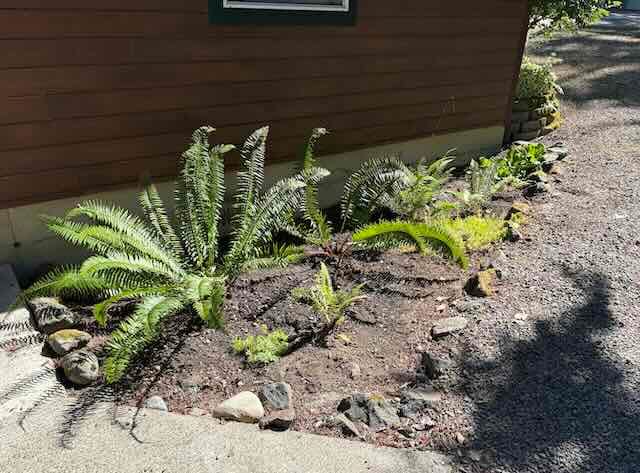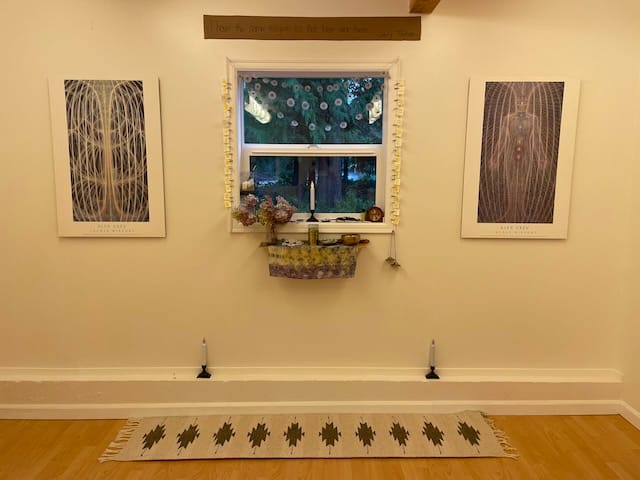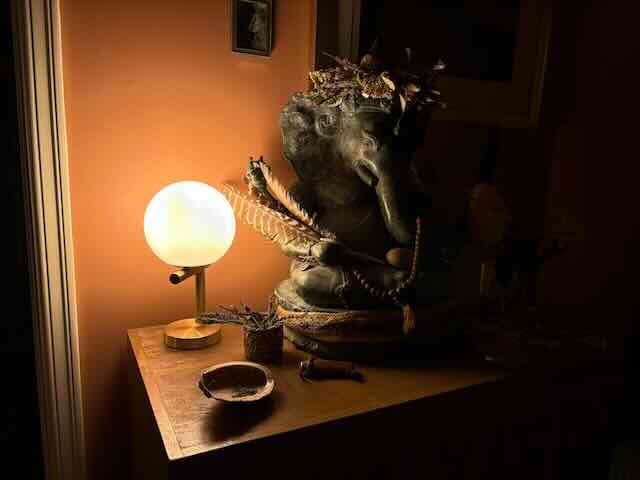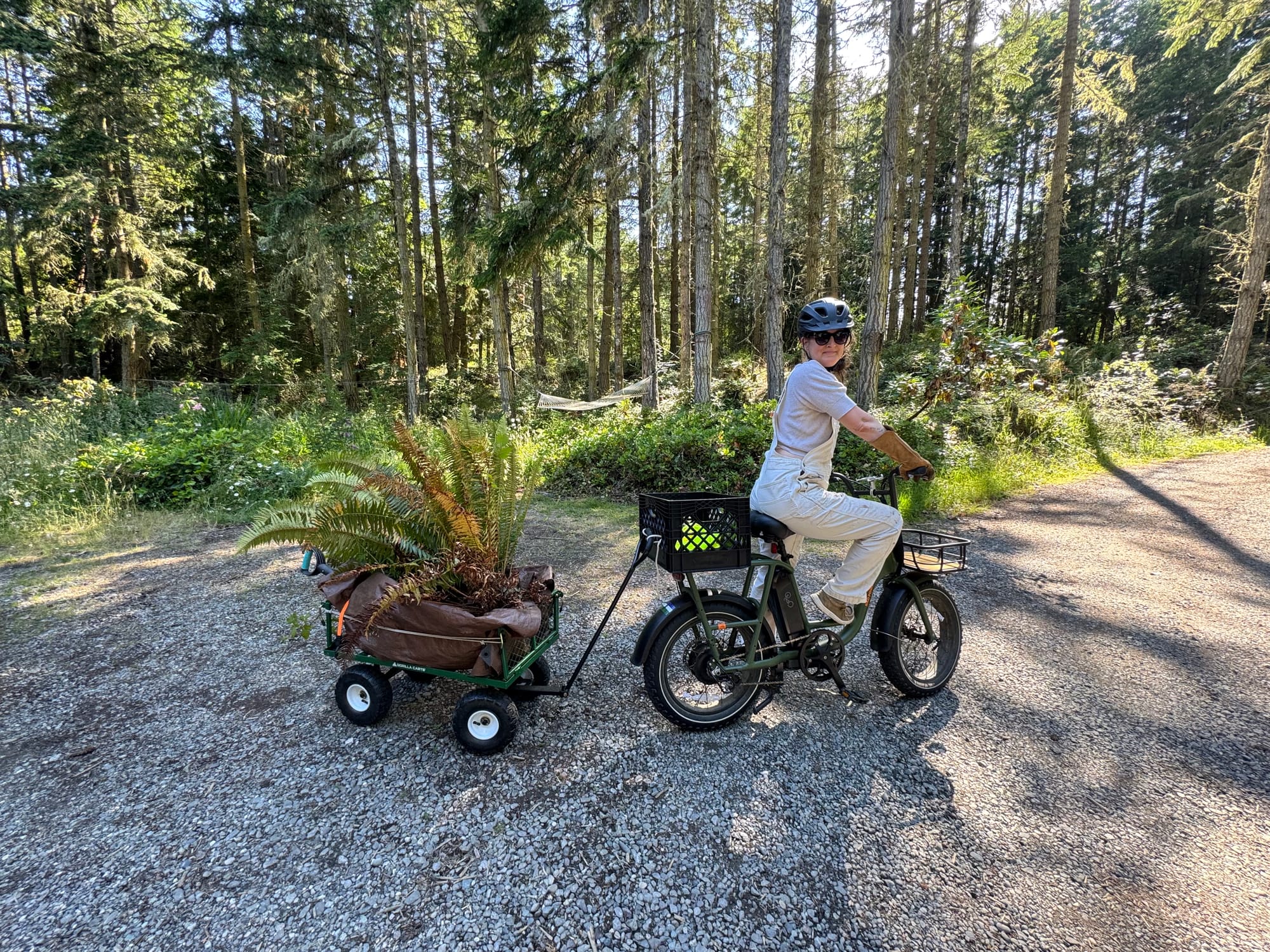Beloved friends,
Last summer I had my first experiences with the wonder of gardening in community. One neighbor was gifting oregano plants via Buy Nothing as she thinned her beds. Another neighbor offered me mint that she had tons of. The lovely lady next door handed me an extra valerian start. A friend texted to ask if I was interested in strawberries that a friend of hers who'd been to my home for yoga was thinning. I said yes, and a few minutes later my doorbell rang. There was my friend's friend, trunk full of boxes of strawberry plants. I took some and sent her toward the person who had gifted me mint. The circle flows!
Those strawberries are on the back deck now growing beautiful berries. Every afternoon this week as I water and watch them ripen, I think "I should let them go another day", then wonder if the squirrels/raccons/rats/birds or I will eat them. I am glad to grow them, whoever's belly they fill.
Last year I got into the garden-giving spirit and emptied an unthriving and not-to-my-taste flowerbed beside the front door by listing the primroses in it on Buy Nothing. For a week everyone who came to my house left with a box or a bucket of primrose tubers. "You're here for a massage? May I send you home with some primroses? Let me grab my spade!" One woman who came for primroses offered to take two pathetic, dying bushes as well, calling herself the Florence Nightingale of plants. She tipped me off kindly that the bergenia left alone in the bed would be happy in the rock garden nearby. My mama came to visit and we spread the bergenia around in the rock garden. I never did plant the empty bed that summer; I'd never planted a whole garden bed before! I just looked at the mud and thought about it for a long time.
This spring I mentioned to my friend Susea that I was thinking to plant some Western Sword Ferns in that bed. Susea said that she had some growing under her clothesline which were quite in the way that she would love to see depart, so this weekend I asked James to help me rig my garden wagon as a bike trailer, toodled carefully down the road to Susea's, and dug.
After planting them I told my friend Karen that I'd begun, and that I was thinking some hostas and sweet woodruff would fill out the bed nicely. Karen said that this is a favorite combination of hers and that I was welcome to come by for sweet woodruff. So I visited with Karen and her sweet German shepherd, then dug up some lovely clumps of sweet woodruff, brought them home, and planted them amongst the ferns. I'd love to just go to the store to buy some hostas, but I'll probably wait until fall when folks are thinning again to see who has some hostas that need a new home, because this is such a heart-filling way to make beauty.
I love to pass things hand to hand, the way it knits and weaves and grows. I went hunting for the news stories I remember seeing long ago about how folks used to pay the toll for the local bridges around San Francisco for the folks behind them as a gift and how this sometimes created long chains of giving and I found a story about how someone paid for the next person's drink at a Starbucks in Florida in 2014 and the chain of accepting the gift and paying for the next person lasted for 378 people. The entire Goenka Vipassana lineage offers their hallmark 10 day silent retreats for free: you may not pay for yours, but at the end, you are given the chance to pay for others; this chain has lasted for 45 years. I'm honored to be a couple of links in that chain, having sat with them in the early 00's.
Recently Karen and her husband Glen had a bumper crop of strawberries. They asked if I'd like some, asking only that I return the paper box so they could use it again. When I did, they gave me more. This continued for a few rounds and I had no garden bounty to return the kindness with yet, so I brought homemade kombucha sweetened with raspberries that the person who showed up at my door with a trunk full of strawberries last summer brought me recently – when returning jars I'd used to gift her bone broth when she was mending after a surgery. The bone broth contained chickens I buy from farmers I know. My garden is made of the gardens of my friends, and oh my gosh, my friends and I are quite literally made of one another's gardens as we eat what grows and it becomes us. We are the life of the land, the life of the community. This interconnection is dizzying and utterly grounding.
In Braiding Sweetgrass, Robin Wall Kimmerer explains that gift economies are common in indigenous cultures. One story that stuck with me is of a visitor to an indigenous people in the Brazilian rainforest. He sees a hunter holding a feast after a particularly big kill. The visitor asks the hunter why he doesn't store his meat for later? The hunter replies, "I store my meat in the belly of my brother."
I asked Karen: didn't she have a freezer for all these berries? She shrugged and said the freezer had plenty and it felt good to share. My friends store their berries in my belly and in the bellies of my friends. I store my kombucha in theirs. Together we inter-are, with one another and with the life of the land. Robin says it another way, too; that in a gift economy, "all flourishing is mutual."
I am reminded of the closing prayer I created, in which I worked hard to balance liberation and interdependence, individuality and community:
May we know peace and wholeness,
freedom and belonging.
May our nurture of these
help them grow within and beyond us
to serve the good of all.
May all beings everywhere
know peace and wholeness,
freedom and belonging.



outside the temple, inside the temple, upstairs
It's funny; I only realized when standing at the altar Monday morning that the ferns would be visible there. Before I spent a long time staring at the muddy garden bed I spent a long time sitting in the temple, thinking about where the altar might sit, and what might sit upon it. I knew that the big, beautiful Ganesha which had graced my altar in California was going upstairs, on the private altar in my bedroom, so that he could be loved and honored. I challenged myself not to rely on Hindu sacredness but to honor that of the here-and-now. Eventually I saw: it was the window, the actual here and now! I offer my light and bells, my prayers and prayersongs, and scented smoke from burning lavender and rosemary that grow in my gardens to the sky and the trees, the squirrels and deer. Just outside the altar window sits this garden bed; you can just see the green edging of the window bottom above the ferns. in the left image, above.
I was inspired to turn more strongly to the garden by my post last week: 30 Things That Brought Me Joy This Week. Honestly, that post came about because I was low on spoons and a list seemed easier to write than a narrative. When I finished writing it, my heart was quite lighter, so I invited folks to share in return and several did; what a joy and honor it was to read their lists. It was such an education: each person's pleasures were treasured moments with people they love, communion with the life of the Earth, and precious milestones. We are carrying so much heartbreak and horror now; how good it was to feel the intimate joys of others: someone's daughter went to prom, graduated, turned 18. Someone rang the bell at her final radiation appointment. Someone helped a coworker access travel benefits that will save them thousands of dollars a year – and her dahlias are blooming.
I hope that our joyful moments can nurture us. I hope that they keep us grounded and present and willing to protect what we love. I hope that on the other side of this terrible time, we can grow something new in the muddy wastes being created by greed. May we plant the seeds for that now, now, now, in what this hard time teaches us about what we truly hold dear.
Resources
Neurodiversity-Affirming Birth Research
Anastasia Lattanand is a longtime perinatal massage therapist in the SFBA, now studying at CIIS, and a friend of a friend. She's doing a research study in the birth experiences of autistic people. Her aim is to "amplify the perspectives of autistic adults, support midwives, doulas, and healthcare providers in offering inclusive, respectful care. The findings will be shared through a research paper and brief educational tools for birth professionals and the public." Qualifications: You identify as autistic. Have given birth in the past 10 years. Are not currently experiencing a mental health crisis. Available for a 30-45 minute interview before July 22. Interviews can be conducted in person (SF, East Bay, Marin), via Zoom or phone. Identities will be kept confidential. For more information contact Anastasia at alattanand@myemail.ciis.edu or 415-310-3132.
The Ridiculous and Magnificent Human Adventure
This NYT story opens with the Norwegian explorer who sailed from Peru to Polynesia in 1947 on a freaking balsa wood raft named Kon-Tiki to prove that early humans could have made such a trip – and that's just the backstory for the modern Japanese anthropologists who "built a dugout canoe in order to study another aspect of western Pacific migration: How did ancient humans, more than 30,000 years ago, navigate the powerful Kuroshio current from Taiwan to southern Japanese islands, such as Okinawa, without maps, metal tools or modern boats? 'Since any physical evidence would have been washed away by the sea, we turned to experimental archaeology, in a similar vein to the Kon-Tiki,' Dr. Kaifu said." Apparently experimental archeology involves chopping trees with stone axes while dressed in hides and repeatedly trying to make a perilous sea journey using the materials available to our ancient ancestors: a mother-loving cat-tail raft, a bamboo and rattan raft, and then success: paddling in a hollowed-out log. The combination of determination, whimsy, good science, pure strangeness, and athleticism involved in the modern endeavor is a delight, and oh, the awe at what our ancestors accomplished! NYT gift link.

Learning to Give Care
Perhaps you read last week about how enthused I was after recertifying in Wilderness First Aid. In my opinion, this should be the standard of first aid we all learn. Most folks are outside of the range of fast access to care at some point in their lives and as our excellent instructor April Grisetti pointed out: everywhere is a wilderness setting after a natural disaster. Two days, great skills. I feel more confident than ever before about when to seek medical care for all illnesses and injuries, how to make the call about seeking emergency rescues, and I know what to do while I wait for help. Warmest of recommendations for WildMed: Wilderness Medical Associates International. I'm currently looking over dates for the next level of training – Wilderness First Responder – and thinking that would make a fantastic vacation.
Resistance
Erica Chenoweth and Maria J. Stephan's Why Civil Resistance Works: The Strategic Logic of Nonviolent Conflict is the source of a statistic you might see around a lot now: that it takes 3.5% of a population to bring success via nonviolent means. You can see Erica explain the gist of it in under two minutes here. Beloved community member Jenifer Fernandez Ancona is a political strategist and one of her current campaigns is Instagram's @threepointfivepercent, which seeks to gather and educate people on this topic in effervescent, approachable modern style.
Feeding the teacher
If you'd like to support my work as a writer, healing artist, and minister, becoming a paying subscriber to this newsletter is a great option. You could make a one-time donation here if you prefer. Shopping in my Bookshop sends a 10% commission my way while you get your books! Sharing my newsletter with a friend to spread my work is a wonderful gift, too. Thank you for your support. It is the honor of my life to serve you with devotion.
